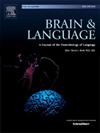Native prosodic structures constrain L2 word recognition: Evidence from Bengali-English bilinguals
IF 2.3
2区 心理学
Q1 AUDIOLOGY & SPEECH-LANGUAGE PATHOLOGY
引用次数: 0
Abstract
Bilingual word recognition is assumed to be modulated by a word’s segmental and meaning similarity across languages, labelled cognate in psycholinguistics, usually conflating borrowed and inherited words. We conducted an ERP fragment priming study with Bengali-English bilinguals. English words borrowed into Bengali (doctor, Bengali: [ˈɖaktar]) were compared with those which were not (river). The stimuli varied in fine metrical details, one-foot (dóctor) or two-feet (éxpèrt) whilst stress placement was kept constant. Crucially, two-feet English words are always one-foot in Bengali [ˈeksparʈ]. Behavioural results (RTs) showed that although loan status did not affect priming, mismatch in feet significantly reduced the effect. In the ERP data, only one-foot words elicited significant priming effects. Furthermore, different ERP components were modulated depending on loan type. Thus, loan status alone is not sufficient to understand L2 word processing; the influence of the native metrical structure (preference for a single foot) constrains processing of all words.
母语韵律结构限制二语单词识别:来自孟加拉语-英语双语者的证据
双语词的识别被认为是由一个词在不同语言中的词段和词义相似性所调节的,在心理语言学中被称为同源词,通常是将借来的词和继承来的词混为一谈。我们对孟加拉语-英语双语者进行了ERP片段启动研究。把从孟加拉语中借来的英语单词(doctor,孟加拉语:[[r]])和没有从孟加拉语中借来的单词(river)进行比较。刺激在精细的测量细节上变化,一英尺(dóctor)或两英尺( xp),而应力放置保持不变。至关重要的是,两英尺长的英语单词在孟加拉语中总是一英尺长的。行为结果(RTs)表明,尽管贷款状态不影响启动,脚的错配显著降低了效应。在ERP数据中,只有一英尺词引发了显著的启动效应。此外,根据贷款类型,不同的ERP组件也有不同的调整。因此,仅借阅状态不足以理解第二语言文字处理;本地格律结构的影响(偏爱单音步)限制了对所有单词的处理。
本文章由计算机程序翻译,如有差异,请以英文原文为准。
求助全文
约1分钟内获得全文
求助全文
来源期刊

Brain and Language
医学-神经科学
CiteScore
4.50
自引率
8.00%
发文量
82
审稿时长
20.5 weeks
期刊介绍:
An interdisciplinary journal, Brain and Language publishes articles that elucidate the complex relationships among language, brain, and behavior. The journal covers the large variety of modern techniques in cognitive neuroscience, including functional and structural brain imaging, electrophysiology, cellular and molecular neurobiology, genetics, lesion-based approaches, and computational modeling. All articles must relate to human language and be relevant to the understanding of its neurobiological and neurocognitive bases. Published articles in the journal are expected to have significant theoretical novelty and/or practical implications, and use perspectives and methods from psychology, linguistics, and neuroscience along with brain data and brain measures.
 求助内容:
求助内容: 应助结果提醒方式:
应助结果提醒方式:


